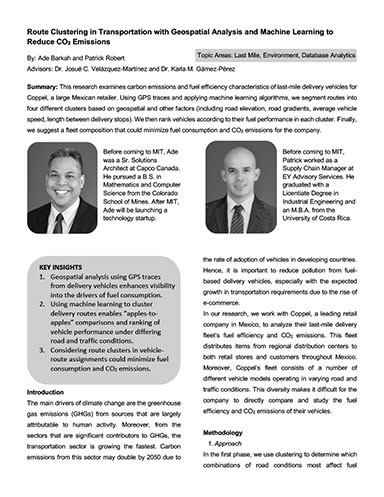Cutting Last-Mile Costs for Large Parcel Deliveries

Researchers at MIT’s Center for Transportation and Logistics worked with a freight services company that specializes in last-mile deliveries of large parcels to address this challenge.
Consumers who find it challenging to bring home large items are increasingly purchasing such products online and requesting delivery to their doorsteps.
A challenge for the freight companies that deliver these large-sized goods is how to remain cost-competitive without compromising the service levels and delivery times that consumers have come to expect.
Researchers at MIT’s Center for Transportation and Logistics worked with a freight services company that specializes in last-mile deliveries of large parcels to address this challenge.
The company wanted to find out whether adding cross-docking facilities to better serve online customers can be justified by the implied savings in transportation costs.
Baseline comparison
The company’s existing distribution network includes one cross-docking facility per metropolitan area, a configuration that results in relatively lengthy stem times (the amount of time taken by a vehicle from when it leaves a cargo facility to when it completes delivery to the customer).
Reducing stem times was one of the company’s goals. Also, as an asset-light operator, the enterprise is mindful that the drivers it hires want to be working, not waiting, so increasing the efficiency of its delivery network is desirable.
For these reasons, the company needed to understand the cost and delivery implications of adding cross-docking facilities to its distribution network.
The researchers gathered information on the existing network to build a baseline scenario. The study encompassed the company’s seven largest markets: Atlanta, Dallas, Chicago, San Francisco, Los Angeles, Newark, and New York City.
There were several metrics the company wanted to compare when considering a new network design. First, how many miles it would take to reach a customer.
Currently, the average distance driven to complete delivery is 35 miles. Second, the enterprise pays additional fees for customers who live more than 50 miles away from a cargo facility; 15% of customers reside in this category in the baseline customer pool. Third, the company leases its cargo facilities, and wanted to know how much lease fees would be if it changed the network’s configuration. The leasing rate is presently about $14/square ft/year.
A more cost-efficient network
Having established a baseline scenario, the researchers analyzed how alternative network configurations stacked up in terms of delivery performance and cost.
Two modelling techniques were used to provide this insight. A demand-based methodology generated additional cross-docking options. Facility costs were based on current market rates by zip code for the new locations, and the model provided 84 total cross-docking locations from which to choose.
In addition, the researchers built a model that included customer demand, facility options, transportation, and facility costs. The model optimized on cost and provided recommendations for new cross-docking facilities.
While the researchers collected information for several scenarios, the most practical network solution was to keep the company’s existing facilities open. The new network design added seven cross-docking facilities for a total of 14 to service all markets. Doubling the number of facilities reduced the average distance to service the customer by 14 miles.
Only 8% of customers are located more than 50 miles away from a cross-docking facility, a seven percentage point improvement. Based on competitive market rates for industrial leases, the total average lease cost for the new network was $10/square ft/year, $4 less than in the baseline case.
Given the assumptions in the model, the optimized network design presented about a 20% improvement in total facility and transportation costs.
The SCM research project Facility Location Optimization for Last-Mile Delivery is authored by Brittany C. Collins and Hao Wang and supervised by Dr. Sergio Caballero, Research Scientist, MIT CTL. For more information on the research, please contact Sergio Caballero at [email protected].
Related: An Alternative Route to a Fuel-Efficient Last Mile 
Learning from Route Plan Deviation in Last-Mile Delivery
Urbanization and customer demands are making last-mile delivery optimization increasingly complex and important for retail companies. Download Now!
Route Clustering in Transportation with Geospatial Analysis and Machine Learning
This research examines carbon emissions and fuel efficiency characteristics of last-mile delivery vehicles for Coppel, a large Mexican retailer. Download Now!
Article Topics
MIT Center for Transportation and Logistics News & Resources
Supply Chain’s Next Decade of Dealing With the Unknown Sustainability Efforts Continue to Ramp Up, Research Finds Supply Chain Sourcing Alternatives to China DAT’s Caplice Reviews Spot Market Strategy for 2024 Budget Planning Yellow’s Demise Underscores the Need for a New Labor Relations Narrative Is Your Supply Chain Talent Ready for the Future? The Rebound Podcast: Yossi Sheffi and The Magic Conveyor Belt More MIT Center for Transportation and LogisticsLatest in Business
FedEx Announces Plans to Shut Down Four Facilities Women in Supply Chain: Ann Marie Jonkman of Blue Yonder U.S. Manufacturing is Growing but Employment Not Keeping Pace The Two Most Important Factors in Last-Mile Delivery Most Companies Unprepared For Supply Chain Emergency Microsoft Unveils New AI Innovations For Warehouses Let’s Spend Five Minutes Talking About ... Malaysia More Business















